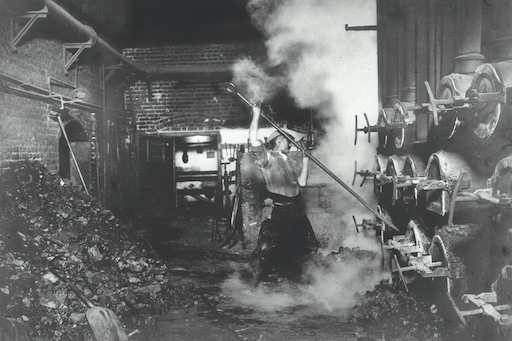
Countess Courtyard
A Self-Reliant Industry

Manufacturing gas for lighting, Halifax, c.1913. Science Museum Group. Image no. 1913-135_3_1.
We currently find ourselves on the site of the North Eastern Railway’s former miniature gasworks. Back when this place first opened in 1891, it wasn’t electricity that powered railway lighting, it was coal gas.
It may be hard to imagine that anything so industrial would belong in what is now an open-air courtyard setting, but back in the late nineteenth century this would’ve been a very cramped, very hot room full of coal, fire and the strong smell of sulphur.
To really get a feel for the gasworks as they once were, let’s imagine we’ve built four walls around the space in front of us. The back wall would be full of neatly positioned holes called ‘retorts’, around the size of a typical computer screen, and these would each have a small iron door fitted so they could be locked and unlocked accordingly. This was an extremely important feature, because behind them was a roaring furnace. Workers would spend the day shoveling coal into these retorts where it would burn to form a gaseous mixture of hydrogen, methane and carbon monoxide. People called this ‘illuminating gas’ because it would shine brightly when lit by a flame.
Let’s go back to the year 1891, when railways needed this gas to light their train carriages and station platforms at night. Rather than exporting work further afield, it was quicker, cheaper and easier for York to build its very own gasworks that could produce everything it needed. The same goes for iron, concrete, blacksmithing and carriagework. Even the water that was used to power steam engines came directly from the River Ouse! So not only do we find ourselves on the site of the miniature gasworks, we’re actually looking over a symbol of the railway’s self-reliance and proud independence.